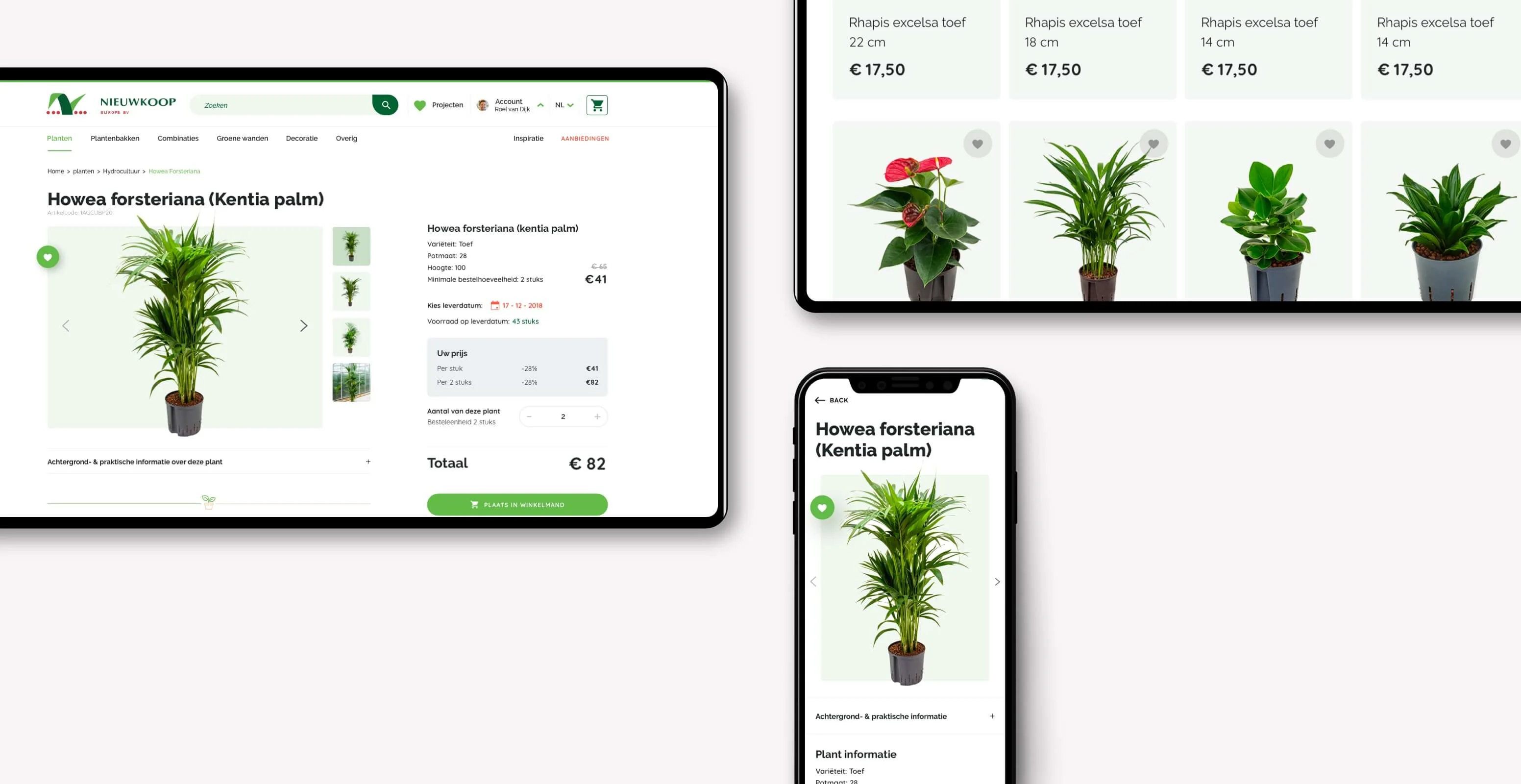Nieuwkoop Europe is an international frontrunner in the specialized market for indoor landscaping. An increasing proportion of trading takes place online. In order to optimally serve customers and to unburden them further, Nieuwkoop Europe therefore wanted a mouth-watering web store.
An eCommerce platform prepared for the unknown
Nieuwkoop got in touch with us with a clear idea for their digital store. They wanted a completely new platform with a sleek design. A B2C eCommerce experience in a B2B environment. Because they could see a lot of potential for growth there.
We saw that potential, too. But before we got started, we first talked extensively about the project’s technical foundation. We advised Nieuwkoop to opt for a headless eCommerce platform. That would require extra investment, but the heavier foundation would definitely pay for itself. A headless platform is future-proof, and new touchpoints can be added quickly and easily. Think, for example, of a mobile app.
MACH enabled platform
Despite being situated in a traditional industry, Nieuwkoop Europe saw an opportunity to embrace the modern MACH philosophy early on:
Microservices: Four separate services (product, price, carts, mail) were built for Nieuwkoop using Node JS. The setup created potential for new services to be added in the future.
API-first: Both for back-end and front-end communications APIs were realized in order to create a flexible landscape, leveraging the power of the existing ERP and taking maximum advantage of the existing functionality of both Commercetools and Contentful.
Cloud-native: The front-end and microservices layer live in the Azure cloud together with Cloudflare. With this cloud setup, Nieuwkoop is able to scale as needed.
Headless: Of course this whole setup was headless by design and used software solutions with the same architectural principles. The custom front-end was built using Angular and a separate CDN (a.o. for security purposes). This creates maximum flexibility in the front-end for Nieuwkoop to present their product offering in the way they want.
Incentro’s pragmatic approach appealed to us from the very beginning. In no time at all, they had a team set up for us to get started. Fast communication, work speed and fun while working!
Our approach to an architecture transition
We created a solid basis for success in Nieuwkoop Europe’s architecture transition by preparing extensively before beginning development. We followed these processes:
Inception deck: Two workshops to understand the vision and (overall) scope of the project.
Basecamp: Several workshops to further define several subjects (including solution, design, architecture, product/pricing, SEO).
Sprint 0: Creating a complete backlog (user story level) based on the basecamp outcomes plus an update on expected investment.
Go/No Go: Starting development.
With this approach, we made sure expectations from both parties were clear. This created a smooth start to the project.
During execution, we used SCRUM to plan and execute work, but from a scope perspective, we worked in an old-fashioned waterfall way. After completing development (and acceptance) we planned a separate “go-live” week and after-care period in which we fixed some non-blocking issues from the acceptance phase.
The result: a smooth UX flow for B2B-customers
The realized solution delivered the goals that Nieuwkoop Europe set and more. B2B customers now experience a smooth UX flow with a B2C e-commerce look and feel.
Impact for the users
We went from an old digital product inventory list to a modern digital experience that inspires visitors and enables new features like cross-selling. By fully embracing customer-centricity, online sales have become a large part of Nieuwkoop Europe’s business model. The e-commerce turnover share moved from 45% in 2018 to 70% in 2021.
Excellent UX both at the front- and back-end
The transition from a desktop-focused legacy platform fueled many benefits for everyday users and Nieuwkoop Europe itself. Where the company heavily relied on internal sales staff to aid customers in their journey through the website, it moved to a new, more advanced search system and a clean and simple my-account for all customers (adding order history and management of delivery). This reduced calls to the internal sales staff significantly.
Cost reductions are not only driven by the new best-in-class experience on the front-end but there are also a lot of benefits on the other side, due to embracing MACH principles. The headless nature of the platform makes it easy to add new microservices like new (external) product configurators. This architecture is a prime example of a scalable and flexible open architecture.
In the end, embracing the MACH philosophy also helped their customers to do their business in a more efficient and effective way. In moving to a MACH-enabled platform, they’re able to claim a value proposition of inspiration, market authority and easy access.


